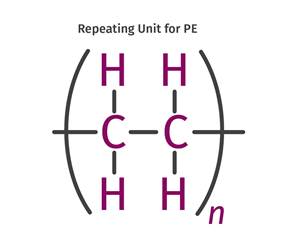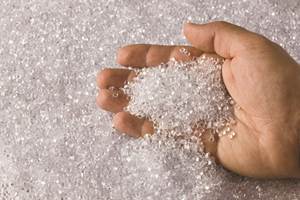Boron Nitride Looks Promising As A Polyolefin Processing Aid
Boron nitride may well become the next processing aid of choice for polyolefin extrusion, blow molding and blown film.
Boron nitride may well become the next processing aid of choice for polyolefin extrusion, blow molding and blown film. A solid lubricant whose structure resembles graphite, boron nitride (BN) has been used as a nucleating agent in fluoropolymer foams for tubing and thermal insulation. It now looks very promising as a processing aid for polyolefins and other thermoplastics, where it may replace or supplement standard fluoroelastomer processing aids.
While most of the research on BN in polyolefins has centered on simple tubular extrusion and wire coating, work is now under way in blow molding, and blown film tests appear to be next on the agenda.
R&D progresses
In 1997, DuPont Co. in Wilmington, Del., received a process patent on incorporating BN particles in polyolefins and fluoropolymers. Last December, DuPont granted BN producer Carborundum Corp. of Amherst, N.Y., an exclusive license to use the technology in thermoplastics other than fluoropolymers. Carborundum is using DuPont's testing facilities to continue the R&D work in conjunction with the University of British Columbia's Dept. of Chemical Engineering in Vancouver.
Thomas Clere, technical manager at Carborandum, says the company aims to form joint development programs with resin producers and compounders. He also says work is in progress to get FDA food-contact approval. Carborundum has been working with several types of BN differing in particle size, morphology, and surface energy and is developing new grades based on this work. Clere co-authored a paper on this work at the recent SPE Polyolefins 2000 RETEC in Houston.
He says recent research shows that BN can eliminate sharkskin and stick-slip melt fracture in polyethylene extrusion, as do fluoroelastomer processing aids. But unlike Fluroelastomers, BN reportedly also significantly shifts the onset of gross melt fracture to much higher shear rates. What's more, BN functions at use levels of 500 ppm (0.05%), half the amount typical for fluoroelastomers. Clere says use cost is competitive with fluoroelastomers.
Studies on mLLDPE
In one recent study at the University of British Columbia, three types of BN were studied in extrusion with ExxonMobil's Exact 3128 metallocene plastomer and Exceed 116 metallocene LLDPE (mLLDPE). Of the three BN types tested, Carborundum's grade CTF5, a highly pure, 5-10 micron powder, performed the best. Level of dispersion was found to play a crucial role in eliminating melt fracture, according to Prof. Savvas Hatzikiriakos. Blending of BN powder with resin pellets produced little effect on melt fracture. However, good results were obtained when BN powder was premixed with ground resin to make a 10% masterbatch.
In Exact 3128, smooth extrudates were obtained at shear rates above 920 sec(-1). This is well above the critical shear rate for the onset of gross melt fracture of unmodified resin, which is about 42 sec(-1) at 325 F. Optimal performance was obtained with lower BN content. The maximum shear rate of 926 sec(-1) was achieved with BN concentrations of 200 and 1000 ppm, whereas a concentration of 5000 ppm yielded a maximum shear rate of only 617 sec(-1).
Similar results were obtained for Exceed 116 mLLDPE. In neat resin, sharkskin appeared at about 100 sec(-1), followed by gross melt fracture at higher shear rates. Addition of 500 ppm BN eliminated sharkskin and shifted the onset of gross melt fracture to rates approaching 900 sec(-1).
Related Content
Prices of All Five Commodity Plastics On the Way Up
Despite earlier anticipated rollover in prices for most of the volume commodity resins, prices were generally on the way up for all going into the third month of first quarter.
Read MorePrices for PE, PS, PVC, PET Trending Flat; PP to Drop
Despite price increase nominations going into second quarter, it appeared there was potential for generally flat pricing with the exception of a major downward correction for PP.
Read MoreThe Fundamentals of Polyethylene – Part 2: Density and Molecular Weight
PE properties can be adjusted either by changing the molecular weight or by altering the density. While this increases the possible combinations of properties, it also requires that the specification for the material be precise.
Read MoreFundamentals of Polyethylene – Part 3: Field Failures
Polyethylene parts can fail when an inappropriate density is selected. Let’s look at some examples and examine what happened and why.
Read MoreRead Next
See Recyclers Close the Loop on Trade Show Production Scrap at NPE2024
A collaboration between show organizer PLASTICS, recycler CPR and size reduction experts WEIMA and Conair recovered and recycled all production scrap at NPE2024.
Read MoreFor PLASTICS' CEO Seaholm, NPE to Shine Light on Sustainability Successes
With advocacy, communication and sustainability as three main pillars, Seaholm leads a trade association to NPE that ‘is more active today than we have ever been.’
Read MorePeople 4.0 – How to Get Buy-In from Your Staff for Industry 4.0 Systems
Implementing a production monitoring system as the foundation of a ‘smart factory’ is about integrating people with new technology as much as it is about integrating machines and computers. Here are tips from a company that has gone through the process.
Read More













